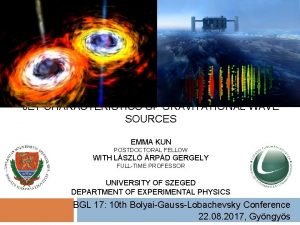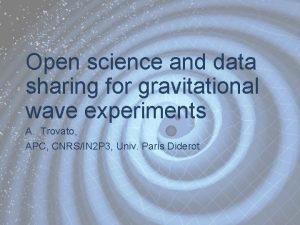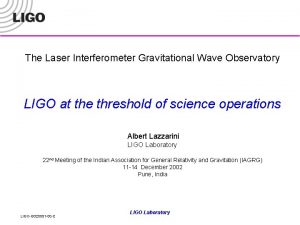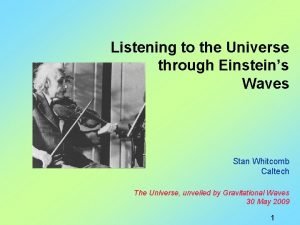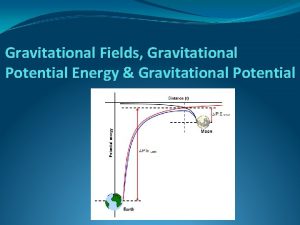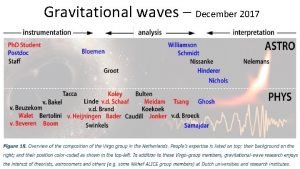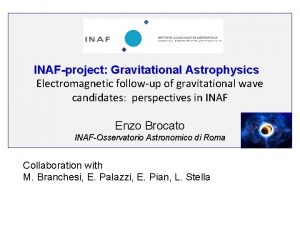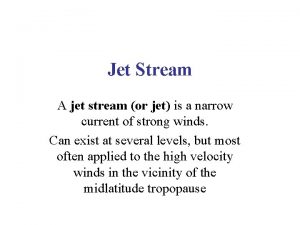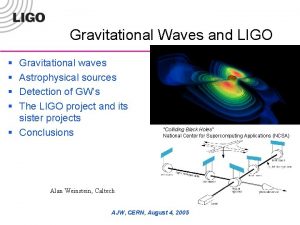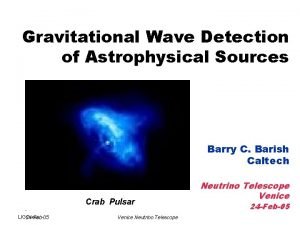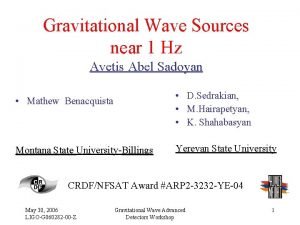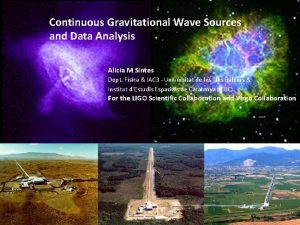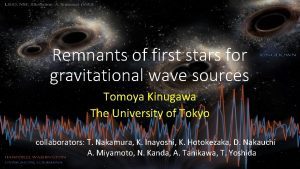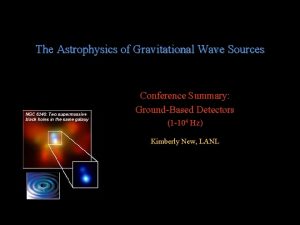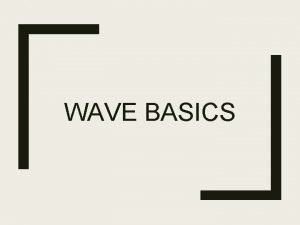JET CHARACTERISTICS OF GRAVITATIONAL WAVE SOURCES EMMA KUN









![Relativistic jets in AGN 3/4 Relativistic beaming 10 δ=1/[γ(1 - βcosι)] Doppler factor, α: Relativistic jets in AGN 3/4 Relativistic beaming 10 δ=1/[γ(1 - βcosι)] Doppler factor, α:](https://slidetodoc.com/presentation_image/8b71dc312319050cdfb41aaddb622b25/image-10.jpg)












- Slides: 22

JET CHARACTERISTICS OF GRAVITATIONAL WAVE SOURCES EMMA KUN POSTDOCTORAL FELLOW WITH LÁSZLÓ ÁRPÁD GERGELY FULL-TIME PROFESSOR UNIVERSITY OF SZEGED DEPARTMENT OF EXPERIMENTAL PHYSICS BGL 17: 10 th Bolyai-Gauss-Lobachevsky Conference 22. 08. 2017, Gyöngyös

The talk will cover 2 Introduction Active galactic nuclei and their jets Observation of possible sources of low-frequency gravitational waves Detection of neutrinos by the Ice. Cube Neutrino Observatory Reorienting jets, as sources of high-energy neutrinos, with a case-study

Introduction 1/3 3 rd window to the Universe – gravitational wave emission 3 First gravitational wave observation in September 14, 2015 https: //www. ligo. caltech. edu/gallery A brand-new window to the Universe Coalescence of astrophysical black holes

Introduction 2/3 Gravitational wave (GW) detectors and sources 4 fgw~TN http: //rhcole. com/apps/GWplotter/ Laser Interferometer Space Antenna http: //lisa. jpl. nasa. gov/gallery/lisa-waves. html The stellar mass binary BHs are already discovered Next challenge is the detection of low-frequency GWs, emitted by more massive black hole binaries

Introduction 3/3 EM counterparts of GW emission 5 The observations will enable testing general relativity in the strong, nonlinear regime Bode et al. (Ap. J, 715, 2, 2010) found that variable electromagnetic (EM) signatures correlated with GWs can arise in merging systems as a consequence of shocks and accretion combined with the effect of relativistic beaming. In the case of the most massive binaries observable by the LISA, calculated luminosities imply that they may be identified by EM searches to z ~1, while lower mass systems and binaries immersed in low density ambient gas can only be detected in the local universe.

Active galactic nuclei 1/2 (AGN) 6 Blazar SDSS© Radio loud Radio galaxy quasar NLR http: //www. jodrellbank. manchester. ac. uk/atlas/object/ Jet SDSS© BLR Black hole Accretion disk d lou iet o di qu Ra dio Ra They host supermassive black holes (106 -1011 MSun) Unification theory of the radio loud AGN: the observed type of the AGN depends in the inclination angle of their jets Dust torii Seyfert 2 Radio quiet quasar Seyfert 1 HST©

Active galactic nuclei 2/2 Continuum spectrum of AGN 7 Schematic overview of a broadband jet model and the various components contributing to the spectral energy distribution (Migliari et al. 2007).

Relativistic jets in AGN 1/4 Relativistic jets 8 The collimated jets are observed as radio loud AGN 10” The Cygnus–A AGN at 5 GHz (VLA) The source-distance is 760 mega-lightyear (z=0, 056, scale 1, 096 kpc/”) National Radio Astronomy Observatory (NRAO)

Relativistic jets in AGN 2/4 Apparent superluminal motion 9 Jet moving with apparent superluminal speed. Source : NRAO
![Relativistic jets in AGN 34 Relativistic beaming 10 δ1γ1 βcosι Doppler factor α Relativistic jets in AGN 3/4 Relativistic beaming 10 δ=1/[γ(1 - βcosι)] Doppler factor, α:](https://slidetodoc.com/presentation_image/8b71dc312319050cdfb41aaddb622b25/image-10.jpg)
Relativistic jets in AGN 3/4 Relativistic beaming 10 δ=1/[γ(1 - βcosι)] Doppler factor, α: spectral index, (Jansky, 1 Jy=10 -26 W/m 2/Hz) n: jetgeometric factor The apparent luminosity L=L 0δn as function of the jetspeed and line-of-sight angle. /Kellerman et al. , 2007/

Relativistic jets in AGN 4/4 Continuum radio spectrum of AGN 11 Different colors different spectral index: very steep almost flat flux density (Jy) Murgia et al. 2000 NGC 326 frequency (GHz) Flat spectrum is due to energetic electrons, with high Lorentz

Observation of possible sources of low-frequency GW sources 1/4 12 Gravitational radiation dominated phase of the merger, from observational point of view q Sub-parsec separated binary systems with years/months/days orbital period, leading to decades of gravitational lifetime q Possible candidates of gravitational waves to detect by the future LISA q It is not possible to spatially resolve these systems, even with the astronomical techniques giving the finest angular resolutions q Indirect methods: q q q q X-shaped galaxies, binary BHs are usually in the inspiral double AGN, far from the final merger periodic jet structures, periodical optical light curves, double peaked emission lines, accretion disks with central cavities, ripples in Fe. Kα X-ray lines high-energy neutrino emission Kun et al. , 2014, 2015

Observation of possible sources of low-frequency GW sources 2/4 Ripples in Fe. Kα X-ray lines 13 q The inner edge of the accretion disk is hot enough to ionize this emission line(E=6. 4 ke. V, λ=0. 19 nm) q The orbital motion of the secondary BH opens a gap in the disk, and it affects the line profile unperturbed Fe. Kα line r=90± 9 RS r=50± 5 RS r=20± 2 RS r=10± 1 RS Mc. Kernan, B. et al. MNRAS, 432, 1468, 2013 Possible sources of strong GW burst within decades

Observation of possible sources of low-frequency GW sources 3/4 14 The X-Ray observations are far more difficult in technique, than e. g. optical observations The S/N of the present X-Ray spectra does not allow to fit such rippled Fe. Kα models ASCA: A model fit (Bromley et al. 1996) to the Fe K-alpha line profile of MCG-6 -30 -15 [Tanaka et al. , Nature 375, 659, 1996] Fit of the Suzaku data of Markarian 3 [Yaqoob et al. MNRAS, 454, 973, 2015]

Observation of possible sources of low-frequency GW sources 4/4 Reorienting jets 15 Before the merger Precession of the dominant spin If the spin is misaligned to the orbital angular momentum: X-shaped galaxies The remnant of the old jet can be seen with the freshly made jet, forming an X-shape Old jet-pair: - steep spectra - old and slow charged particles The spin-direction points the jet direction the jet is precessing with the spin „spin-flip” Flip of the dominant spin, which typically occurs in the typical mass ratio of merging SMBHs [1/30: 1/3] the jet flips with the dominant spin X-shaped galaxies Hodges-Kluck and Reynolds, 2011 New jet-pair: - bright and flat spectrum - young and fast charged particles Gergely and Biermann, 2009 They may hide SMBH binaries that would collide within

Neutrino detection 1/3 Ice. Cube and high-energy neutrinos 16 q Ice. Cube: detection of 55 high-energy neutrino of cosmic origin (Ice. Cube collaboration, Phys. Rev. Lett. , 113, 101101, 2014; Ice. Cube collaboration, ar. Xiv: 1510. 05223; Schoenen Raedel, AT, 7856, 2015) q Their actual origin is not clear, most probably it is the AGN https: //icecube. wisc. edu/

Neutrino detection 2/3 „Track” and „shower”-type neutrino events 17 The electron neutrinos create electrons, the muon neutrinos create muons The electron neutrinos generates „shower”-type neutrino events The muon neutrinos generates „track”-type neutrino events directional uncertainty ~1, 2 o Blazar PKS 0723– 008 Kun et al. , MNRAS Lett. 466, 34, 2017 directional uncertainty ~16 o Blasar PKS B 1424 -418 Kadler et al. , Nature, 12, 807, 2016 Track-type (e. g. ID 5) Shower-type (e. g. ID 35)

Neutrino detection 3/3 Selection of cosmic neutrinos 18 [Ice. Cube Collaboration, Science 342, 1242856, 2013] Background events (99. 9% of the events): Events producing first light in the veto region (shaded area) were discarded as entering tracks (usually from cosmic ray muons entering the detector). The deposited energy is also a veto, only the high-energy (Te. V, Pe. V) neutrinos are considered to be extragalactic.

Reorienting jets, as sources of high-energy neutrinos 1/3 Where can be the neutrinos created in AGN? 19 Energetic proton-proton collisions lead to pion creation E 0, μ+=105, 66 Me. V ELEC=55, 91 Me. V Ep+, min≈290 Me. V vp+, min≈0, 65 c The plunge of a newly formed jet into the environment of the BBH � The Lorentz factor of the freshly made jet is high � Enhanced radiation in all EM frequencies � The spectrum of the AGN is flat up to THz frequencies Its radio flux density is increasing as the electrons are speeding, leading to enhanced synchrotron radiation Neutrino emission Their sources might be the energetic proton-proton collisions (E≥Ep+, min) New jet tunnel forms after the coalescence of the BBH

Reorienting jets, as sources of high-energy neutrinos 2/3 Case study: the blazar PKS 0723– 008 E. Kun, P. L. Biermann, L. Á. Gergely, MNRAS Letters, 466, 34, (2017) 20 Cross-correlation of AGN positions in radio catalogues with the arrival direction of the 15, track-type highenergy neutrino detected by the Ice. Cube (mispointing ~1, 2°) The blazar PKS 0723– 008 is the candidate-source to neutrino event ID 5 Its spectrum is flat upt to 857 GHz MOJAVE data (15 years) � mapping with point sources � modeling with Gauss components � no visible component motion Spectrum of PKS 0723– 008 (NASA/IPAC Extragalactic Database) PCCS 2: α 30 GHz, 857 GHz = -0, 18± 0, 04, α 70 GHz, 545 GHz = 0, 45± 0, 03 Relative declination (mas) Relative right ascension (mas)

Reorienting jets, as sources of high-energy neutrinos 3/3 Surface brightness distribution of the blazar PKS 0723 -008 at the 15 GHz observing frequenc 21 ID 5 2010 -11 -02. BBH merger freshly made jet increasing radio flux density, hardened spectrum, neutrino emission. A possible way to confirm the sources of low-frequency gravitational wave bursts is the detection of high-energy neutrinos accompanied by enhanced radio flux density, and flat radio

22 Thank you for the attention!
 Emmakadler
Emmakadler Yelvington jet aviation jet fuel
Yelvington jet aviation jet fuel Gravitational wave open science center
Gravitational wave open science center Gravitational wave
Gravitational wave Gravitational wave
Gravitational wave Wave could hear murmurs across universe
Wave could hear murmurs across universe Giant gravitational detectors hear murmurs across
Giant gravitational detectors hear murmurs across Print and web sources
Print and web sources Important water resources
Important water resources Vi har kun en sol
Vi har kun en sol Pilkutus
Pilkutus Juramento karate kyokushin
Juramento karate kyokushin Asrga tatigulik kun rejasi
Asrga tatigulik kun rejasi Franz marc modrý kůň
Franz marc modrý kůň Struktur sosial masyarakat kerajaan alam melayu
Struktur sosial masyarakat kerajaan alam melayu Héfaistos
Héfaistos Kun niu
Kun niu Suimei university
Suimei university Margin valuation adjustment
Margin valuation adjustment A szerelem kémiája
A szerelem kémiája Trojský kůň rčení
Trojský kůň rčení Kun tamás
Kun tamás Americký klusák
Americký klusák
